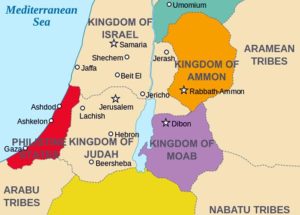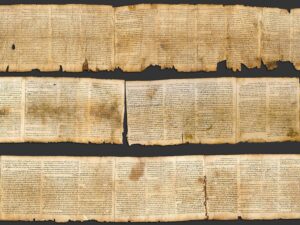The Greatest Offer in History – Turned Down
King Ahaz knew the reputation of prophet Isaiah who had prophesied to two previous kings, his father King Jotham and grandfather King Uzziah.[1] When the prophet spoke, Ahaz was fully aware that Isaiah was speaking directly for God, yet the King turned down the greatest offer ever made by God to a man.
 Ten generations earlier, the House of David was split by God as a punishment for worshiping pagan gods Sidonian goddess Astarte, Moabite god Chemosh and Ammonite god Milcom.[2] God retained Jerusalem and split off 10 tribes of Israel whom He promised to bless if they followed God like David had done.[3]
Ten generations earlier, the House of David was split by God as a punishment for worshiping pagan gods Sidonian goddess Astarte, Moabite god Chemosh and Ammonite god Milcom.[2] God retained Jerusalem and split off 10 tribes of Israel whom He promised to bless if they followed God like David had done.[3]
King Rehoboam, son of Solomon, ruled the nation of Judah from Jerusalem while 10 tribes followed Jeroboam, son of Nebat from the tribe of Ephraim, who became their King of the nation Israel.[4]
Themselves becoming enemies among themselves, two tribes, Manasseh and Ephraim, split off from Israel warring with each other.[5] God even foretold Ephraim as a nation would be eliminated within 65 years.[7]
During the reign of Ahaz, King Pekah of Ephraim allied with King Rezin of Syria (Aram or the Arameans) to attack Judah and besieged Jerusalem. Inside the city, Ahaz and the people were greatly distressed and in an effort to calm their fears, God sent Isaiah promising protection to Jerusalem and King Ahaz.[6]
Assuring the shaken King of God’s promise of protection, Ahaz was given the unprecedented opportunity to ask for a miraculous sign with boundless limitations – any sign between Heaven and Hell to prove His promise was indisputable:

Is 7:11 “Ask a sign for yourself from the LORD your God; make it deep as Sheol or high as heaven.”(NASB)
Ahaz said to Isaiah, “I will not ask, nor will I test the LORD!”[8] Unbelievably,the King refused to take the offer declining the unique opportunity to choose any sign between Heaven and Hell!
Knowing the true reason for Ahaz’ response and not taking kindly to this attitude, Isaiah’s response certainly didn’t ease the King’s anxieties: “Is it too slight a thing for you to try the patience of men, that you will try the patience of my God as well?”[9]
No longer speaking just to the King, God’s response through Isaiah addressed a much broader audience, “Listen now, O house of David!”[10] God’s response to Ahaz’ attitude was now broadened in effect saying, “now let me tell the whole kingdom of David about God’s marvelous sign!”
Unequivocal parameters of the sign had already been established with God’s initial offer to the King to choose any sign between Heaven and Hell. Now God now raised the bar even higher with a prophecy so fantastic, so exceptional, it would require a miracle:
Is 7:14: “Therefore the Lord Himself will give you a sign: Behold, the virgin shall conceive and bear a Son, and shall call His name Immanuel.” (NKJV)
Seemingly impossible, Isaiah foretold of the virgin giving birth. Compounded by three requirements, it makes the prophecy of Isaiah 7:14 very precise.
First, the prophecy precisely uses hā-‘al-māh specifically translated as the virgin. It is the only time “almah” terminology is used to refer to a female since the Law was handed down to Moses at Mt. Sinai.
Before the Law was given, in only two instances is a female specifically identified as a virgin – Rebekah, the virgin bride of Isaac, and Miriam, the virgin sister of Moses.[11]
Two other specifics: Isaiah foretold the gender of the virgin’s child would be a boy and he was named by God, a Biblical rarity. In-spite-of specifics, detractors abound.
Various rationalizations by skeptics assert Isaiah 7:14 is not a Messiah prophecy with some arguing the prediction was really about an unidentified young female who was present with King Ahaz and Isaiah.[12] Jewish sage Rabbi Rashi espoused the prophecy was about Manoah’s wife, mother of Sampson, the Biblical strongman.[13]
Additional critics contend the Christian Bible is a mistranslation, a misinterpretation, or an error.[14] A few go so far as to accuse Christians of a conspiracy to intentionally change the text as a false means to support beliefs of Christianity.
Science discoveries and technology advancements debunk some of these charges, especially the Christianity accusations. Qumran discovery of the complete Great Isaiah Scroll, written in ancient Hebrew in 125 BC over a century before Jesus of Nazareth was born, contains the Hebrew words ha-almah, “the virgin.”[15]
Would the promised virgin female’s conception of a baby boy named by God rise to the level of an unparalleled, matchless sign of God; a Messiah prophecy?
Updated December 8, 2024.
This work is licensed under a Creative Commons Attribution-NonCommercial-NoDerivatives 4.0 International License.
REFERENCES:
[1] 2 Chronicles 26.22-23; 27:1-2; 2 Kings 15:32-34, 38; Isaiah 1:1; 7:1.
[2] I Kings 11:4-8, 33; I Chronicles 3:10-13.
[3] I Kings 11:26-49.
[4] I Kings 12:16-20, 26.
[5] I Kings 14:30. Isaiah 9:21.
[6] Isaiah 7:2.
[7] Isaiah 7:2, 8. “Special Offer|Exclusive.” FreePNGimg.com. photo. 2022. <https://freepngimg.com/download/special_offer/12-2-special-offer-picture.png>
[8] Isaiah 7:12. NASB, NKJV.
[9] Isaiah 7:13.
[10] NKJV.
[11] Isaiah 7:14. Bible Hub. Hebrew text. <https://biblehub.com/text/isaiah/7-14.htm> Genesis 24:43. Bible Hub. Hebrew text. <https://biblehub.com/text/genesis/24-43.htm> Exodus 2:8. Hebrew text. BibleHub. <https://biblehub.com/text/exodus/2-8.htm>
[12] Nahigian, Kenneth E. “A Virgin-Birth Prophesy?” Skeptic Tank Files. n.d. <http://www.skeptictank.org/files/sr/2virgi93.htm> Cramer, Robert Nguyen. “The Book of Isaiah.” The BibleTexts.com.. 1998 <http://www.bibletexts.com/verses/v-isa.htm> Cline, Austin. “Who Was Virgin Mary, Mother of Jesus? Was She Really a Virgin?” About.com|Agnosticism/Atheism. n.d. <http://atheism.about.com/od/biblepeoplenewtestament/p/MaryVirgin.htm> Yosef, Uri. “Isaiah 7:14 – Part 1: An Accurate Grammatical Analysis.” The Jewish Home. 2011. <http://thejewishhome.org/counter/Isa714_1.pdf> Bratcher, Dennis. “Isaiah 7:14: Translation Issues.” The Voice. 10 Feb. 2014. <http://www.crivoice.org/isa7-14.html> The Complete Jewish Bible with Rashi Commentary. Yeshayahu- Isaiah 7:14. <https://www.chabad.org/library/bible_cdo/aid/15938/showrashi/true> “Who is the Almah’s son?” Teshuvas HaMinim. 2011. <http://web.archive.org/web/20120425022737/http://www.teshuvashaminim.com/isaiah714.html>
Robinson, B.A. “Isaiah 7:14 “Behold, a virgin shall conceive…”” Religious Tolerance. 2007 <http://www.religioustolerance.org/chr_proi.htm> Gill. John Gill’s Exposition of the Whole Bible. Isaiah 7:14 commentary. <https://www.studylight.org/commentaries/geb/isaiah-7.html>
[13] The Compete Jewish Bible- with Rashi Commentary. Isaiah 7:14, CR Judges Chapter 13.
[14] Nahigian. “A Virgin-Birth Prophesy?” Cramer. “The Book of Isaiah.” Cline, Austin. “Who Was Virgin Mary, Mother of Jesus? Was She Really a Virgin?” Yosef, Uri. “Isaiah 7:14 – Part 1: An Accurate Grammatical Analysis.” Bratcher, Dennis. “Isaiah 7:14: Translation Issues.”
[15] “Isaiah 7:14-Deception In The Name Of Jesus.” Agnostic Review of Christianity. n.d. <http://agnosticreview.com/isaiah7.htm> Miller. Fred P. “The Translation of the Great Isaiah Scroll.” Book of Isaiah. Column VI Isa 6:7 to 7:15. 2001. <http://www.moellerhaus.com/qa-tran.htm> Miller. Fred P. “Commentary on Isaiah – In-depth verse-by-verse study of Isaiah.” Moellerhaus Publisher. 1999. <http://moellerhaus.com/7-8.htm> Isaiah 7:14. Bible Hub. Hebrew text. <https://biblehub.com/text/isaiah/7-14.htm> Isaiah 7:14 BibleHub.com. Interlinear Bible Hebrew text “5959 [e] hā·‘al·māh”. <http://biblehub.com/interlinear/isaiah/7-14.htm> Orthodox Jewish Bible (OJB) translation for Isaiah 7:14. <https://biblehub.com/ojb/isaiah/7.htm>

